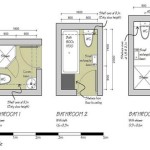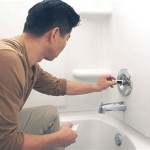How To Change A Bathroom Wall Tile
Replacing a bathroom wall tile can be a necessary task for homeowners due to various reasons, including damage, outdated aesthetics, or the need to access plumbing behind the wall. This process, while seemingly complex, can be accomplished by a diligent individual with the right tools and a methodical approach. This article provides a comprehensive guide on how to successfully change a bathroom wall tile, covering the necessary preparations, removal of the old tile, surface preparation, installation of the new tile, and finishing touches.
Preparation is Paramount: Gathering Tools and Materials
Before commencing any work, gathering the necessary tools and materials is of utmost importance. This ensures a smooth and efficient workflow and minimizes potential delays. The following items are essential for changing a bathroom wall tile:
Safety Gear: Safety goggles are crucial for protecting the eyes from debris and dust generated during tile removal. Gloves are required to protect hands from sharp edges and potential chemical irritants in adhesives and grout. A dust mask prevents inhalation of airborne particles, safeguarding respiratory health.
Tile Removal Tools: A grout saw or a utility knife is utilized to remove the grout surrounding the damaged tile. A hammer and chisel are needed to carefully break and remove the tile. A putty knife or scraper is used to remove old adhesive from the wall surface. A pry bar might be helpful for particularly stubborn tiles, but its use requires extreme caution to avoid damaging adjacent tiles.
Surface Preparation Tools: A stiff brush or sponge is necessary for cleaning the wall surface after the old tile is removed. Sandpaper or a sanding block is used to smooth out any rough areas or remaining adhesive. A level is essential to ensure that the new tile is installed straight and flush with the surrounding tiles.
Tile Installation Tools: A notched trowel is used to apply the thin-set mortar adhesive evenly to the wall. Tile spacers are critical for maintaining consistent grout lines. A rubber mallet can be used to gently tap the new tile into place. A tile cutter or wet saw is needed if the new tile needs to be cut to size.
Materials: Replacement tile matching the existing tiles in size, color, and style is essential. Thin-set mortar adhesive is used to adhere the new tile to the wall. Grout, matching the existing grout color, is used to fill the gaps between the tiles. Grout sealant protects the grout from moisture and staining. Clean rags or sponges are necessary for cleaning up excess adhesive and grout.
Securing these tools and materials before starting the tile replacement process is a crucial first step towards a successful outcome.
Removing the Old Tile: A Delicate Process
The removal of the old tile requires a careful and methodical approach to minimize damage to surrounding tiles and the underlying wall surface. Rushing this step can lead to additional complications and increase the overall repair time.
Grout Removal: Using a grout saw or a utility knife, carefully remove the grout surrounding the damaged tile. Apply steady pressure and work along the grout lines, being mindful not to scratch or damage the adjacent tiles. It is beneficial to remove as much grout as possible, as it will facilitate the removal of the tile.
Breaking the Tile: Once the grout is removed, use a hammer and chisel to carefully break the damaged tile. Start by creating a crack in the center of the tile and then gradually work outwards. Avoid striking the surrounding tiles directly, as this can cause them to crack or become dislodged. Wear safety goggles throughout this process to protect the eyes from flying debris.
Tile Removal: After breaking the tile into smaller pieces, use the chisel or putty knife to carefully pry the pieces away from the wall. Work slowly and patiently, applying steady pressure to loosen the adhesive. If a piece of tile is particularly stubborn, try tapping it gently with the hammer and chisel to break the adhesive bond.
Adhesive Removal: Once the tile is removed, use a putty knife or scraper to remove any remaining adhesive from the wall surface. Apply moderate pressure and work at an angle to effectively scrape away the adhesive. For stubborn adhesive residue, a heat gun can be used to soften it, making it easier to remove. However, extreme caution should be exercised to prevent overheating the wall surface or damaging nearby materials.
Wall Inspection: After removing the old tile and adhesive, carefully inspect the underlying wall surface for any damage, such as cracks, crumbling plaster, or water damage. Repair any damage before proceeding with the installation of the new tile. If the wall is severely damaged, it may be necessary to consult with a professional to ensure that the surface is properly prepared for tile installation.
Thorough removal of the old tile and preparation of the underlying wall surface are critical for ensuring a strong and lasting bond with the new tile.
Installing the New Tile: Precision and Accuracy
The installation of the new tile requires precision and accuracy to ensure a seamless and aesthetically pleasing result. Taking the time to do it right will prevent future problems and maintain the integrity of the bathroom wall.
Dry Fit: Before applying the adhesive, perform a dry fit of the new tile. This involves placing the tile in the opening without adhesive to ensure that it fits properly and aligns with the surrounding tiles. Use tile spacers to maintain consistent grout lines. If the tile is too large, use a tile cutter or wet saw to cut it to the correct size. It is generally recommended to slightly undersize the tile to accommodate the grout lines and ensure a flush fit.
Applying the Adhesive: Using a notched trowel, apply a thin, even layer of thin-set mortar adhesive to the back of the new tile and to the wall surface. The depth of the notches on the trowel will determine the thickness of the adhesive layer. Follow the manufacturer's instructions for the correct trowel size and adhesive application technique. Ensure that the entire surface of the tile is covered with adhesive, but avoid applying too much, as this can cause the tile to slip or bulge.
Setting the Tile: Carefully place the new tile in the opening, aligning it with the surrounding tiles. Press firmly on the tile to ensure that it is properly seated in the adhesive. Use a rubber mallet to gently tap the tile into place, ensuring that it is level and flush with the surrounding tiles. Insert tile spacers between the new tile and the adjacent tiles to maintain consistent grout lines. Remove any excess adhesive that squeezes out from between the tiles with a damp sponge.
Curing Time: Allow the adhesive to cure according to the manufacturer's instructions. This typically takes 24 to 48 hours. Avoid disturbing the tile during this time, as this can weaken the bond between the tile and the wall. After the adhesive has cured, remove the tile spacers.
Grouting: Mix the grout according to the manufacturer's instructions. Using a grout float, apply the grout to the grout lines, pressing it firmly into the gaps. Work diagonally across the grout lines to ensure that they are completely filled. Remove excess grout from the surface of the tiles with a damp sponge. Rinse the sponge frequently in clean water to avoid smearing the grout.
Grout Cleanup: After the grout has partially dried (typically after 15-30 minutes), use a clean, damp sponge to remove any remaining grout haze from the surface of the tiles. Rinse the sponge frequently in clean water. Polish the tiles with a dry cloth to remove any remaining residue.
Sealing the Grout: After the grout has fully cured (typically after 72 hours), apply a grout sealant to protect it from moisture and staining. Follow the manufacturer's instructions for the application of the sealant. This will prolong the life of the grout and prevent the growth of mold and mildew.
Accurate installation of the new tile, proper grouting techniques, and effective grout sealing are vital for achieving a durable and aesthetically pleasing finished product.
Finishing Touches: Ensuring a Professional Look
The final stage involves performing some finishing touches. These often-overlooked details can contribute significantly to the overall professional appearance of the completed tile replacement.
Caulking: Apply caulk to any joints where the tile meets other surfaces, such as the bathtub, shower stall, or countertop. Caulk creates a watertight seal that prevents water from seeping behind the tile and causing damage. Choose a caulk that is specifically designed for use in bathrooms and is resistant to mold and mildew. Apply the caulk in a smooth, even bead and use a wet finger or a caulking tool to smooth it out.
Hardware Reinstallation: If any hardware, such as towel bars, soap dishes, or shower heads, was removed during the tile replacement process, reinstall it now. Ensure that the hardware is securely attached to the wall and that it is aligned properly. Consider replacing old or damaged hardware with new fixtures to enhance the overall appearance of the bathroom.
Final Cleaning: Give the entire area a final cleaning to remove any dust, debris, or grout residue. Use a mild detergent and a damp cloth to wipe down the tiles and surrounding surfaces. Polish the tiles with a clean, dry cloth to restore their shine.
Careful attention to these finishing touches will ensure that the replaced tile blends seamlessly with the existing bathroom décor and provides a long-lasting and visually appealing result.

How To Remove A Bathroom Wall Tile Today S Homeowner

The Best Way To Remove Old Shower Tile

A Diy Shower Tile Step By

How To Tile A Bathroom Wall Granada Cement Blog Ideas Tips And More

How To Remove Replace One Bathroom Tile Ceramic Repair

Edited Removing Tile From Bathroom Walls Hometalk

How To Easily Remove Bathtub Shower Wall

Diy Half Bathroom Demolition The Handyman S Daughter

How To Revitalize Old Bathroom With Tile Refinishing

Shower Tile Installation Step By Four Generations One Roof
Related Posts







